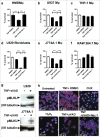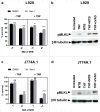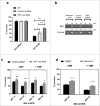Susceptibility of Mycobacterium tuberculosis-infected host cells to phospho-MLKL driven necroptosis is dependent on cell type and presence of TNFα
- PMID: 28892415
- PMCID: PMC5750806
- DOI: 10.1080/21505594.2017.1377881
Susceptibility of Mycobacterium tuberculosis-infected host cells to phospho-MLKL driven necroptosis is dependent on cell type and presence of TNFα
Abstract
An important feature of Mycobacterium tuberculosis pathogenesis is the ability to control cell death in infected host cells, including inhibition of apoptosis and stimulation of necrosis. Recently an alternative form of programmed cell death, necroptosis, has been described where necrotic cell death is induced by apoptotic stimuli under conditions where apoptotic execution is inhibited. We show for the first time that M. tuberculosis and TNFα synergise to induce necroptosis in murine fibroblasts via RIPK1-dependent mechanisms and characterized by phosphorylation of Ser345 of the MLKL necroptosis death effector. However, in murine macrophages M. tuberculosis and TNFα induce non-necroptotic cell death that is RIPK1-dependent but independent of MLKL phosphorylation. Instead, M. tuberculosis-infected macrophages undergo RIPK3-dependent cell death which occurs both in the presence and absence of TNFα and involves the production of mitochondrial ROS. Immunocytochemical staining for MLKL phosphorylation further demonstrated the occurrence of necroptosis in vivo in murine M. tuberculosis granulomas. Phosphorylated-MLKL immunoreactivity was observed associated with the cytoplasm and nucleus of fusiform cells in M. tuberculosis lesions but not in proximal macrophages. Thus whereas pMLKL-driven necroptosis does not appear to be a feature of M. tuberculosis-infected macrophage cell death, it may contribute to TNFα-induced cytotoxicity of the lung stroma and therefore contribute to necrotic cavitation and bacterial dissemination.
Keywords: MLKL; Mycobacterium tuberculosis; RIPK1; RIPK3; fibroblast; macrophage; necroptosis.
Figures




Similar articles
-
NAD+ Depletion Triggers Macrophage Necroptosis, a Cell Death Pathway Exploited by Mycobacterium tuberculosis.Cell Rep. 2018 Jul 10;24(2):429-440. doi: 10.1016/j.celrep.2018.06.042. Cell Rep. 2018. PMID: 29996103 Free PMC article.
-
Cisatracurium besylate rescues Mycobacterium Tuberculosis-infected macrophages from necroptosis and enhances the bactericidal effect of isoniazid.Int Immunopharmacol. 2023 Jul;120:110291. doi: 10.1016/j.intimp.2023.110291. Epub 2023 May 12. Int Immunopharmacol. 2023. PMID: 37182451
-
Opposite Effects of Apoptotic and Necroptotic Cellular Pathways on Rotavirus Replication.J Virol. 2022 Jan 12;96(1):e0122221. doi: 10.1128/JVI.01222-21. Epub 2021 Oct 20. J Virol. 2022. PMID: 34668777 Free PMC article.
-
Viral-induced neuronal necroptosis: Detrimental to brain function and regulation by necroptosis inhibitors.Biochem Pharmacol. 2023 Jul;213:115591. doi: 10.1016/j.bcp.2023.115591. Epub 2023 May 16. Biochem Pharmacol. 2023. PMID: 37196683 Review.
-
Surviving death: emerging concepts of RIPK3 and MLKL ubiquitination in the regulation of necroptosis.FEBS J. 2023 Jan;290(1):37-54. doi: 10.1111/febs.16255. Epub 2021 Nov 16. FEBS J. 2023. PMID: 34710282 Review.
Cited by
-
Targeting necroptosis: a promising avenue for respiratory disease treatment.Cell Commun Signal. 2024 Aug 28;22(1):418. doi: 10.1186/s12964-024-01804-6. Cell Commun Signal. 2024. PMID: 39192326 Free PMC article. Review.
-
The role of Mycobacterium tuberculosis complex species on apoptosis and necroptosis state of macrophages derived from active pulmonary tuberculosis patients.BMC Res Notes. 2020 Sep 4;13(1):415. doi: 10.1186/s13104-020-05256-2. BMC Res Notes. 2020. PMID: 32887662 Free PMC article.
-
Is Receptor-Interacting Protein Kinase 3 a Viable Therapeutic Target for Mycobacterium tuberculosis Infection?Front Immunol. 2018 May 28;9:1178. doi: 10.3389/fimmu.2018.01178. eCollection 2018. Front Immunol. 2018. PMID: 29892302 Free PMC article.
-
Bisphenol A induces coronary endothelial cell necroptosis by activating RIP3/CamKII dependent pathway.Sci Rep. 2020 Mar 6;10(1):4190. doi: 10.1038/s41598-020-61014-1. Sci Rep. 2020. PMID: 32144343 Free PMC article.
-
NAD+ Depletion Triggers Macrophage Necroptosis, a Cell Death Pathway Exploited by Mycobacterium tuberculosis.Cell Rep. 2018 Jul 10;24(2):429-440. doi: 10.1016/j.celrep.2018.06.042. Cell Rep. 2018. PMID: 29996103 Free PMC article.
References
-
- Mariotti S, Sargentini V, Pardini M, Giannoni F, De Spirito M, Gagliardi MC, Greco E, Teloni R, Fraziano M, Nisini R. Mycobacterium tuberculosis may escape helper T cell recognition by infecting human fibroblasts. Hum Immunol. 2013;74:722–9. doi: 10.1016/j.humimm.2013.02.005. PMID:23459076 - DOI - PubMed
Publication types
MeSH terms
Substances
Grants and funding
LinkOut - more resources
Full Text Sources
Other Literature Sources
Medical
Molecular Biology Databases
Miscellaneous
